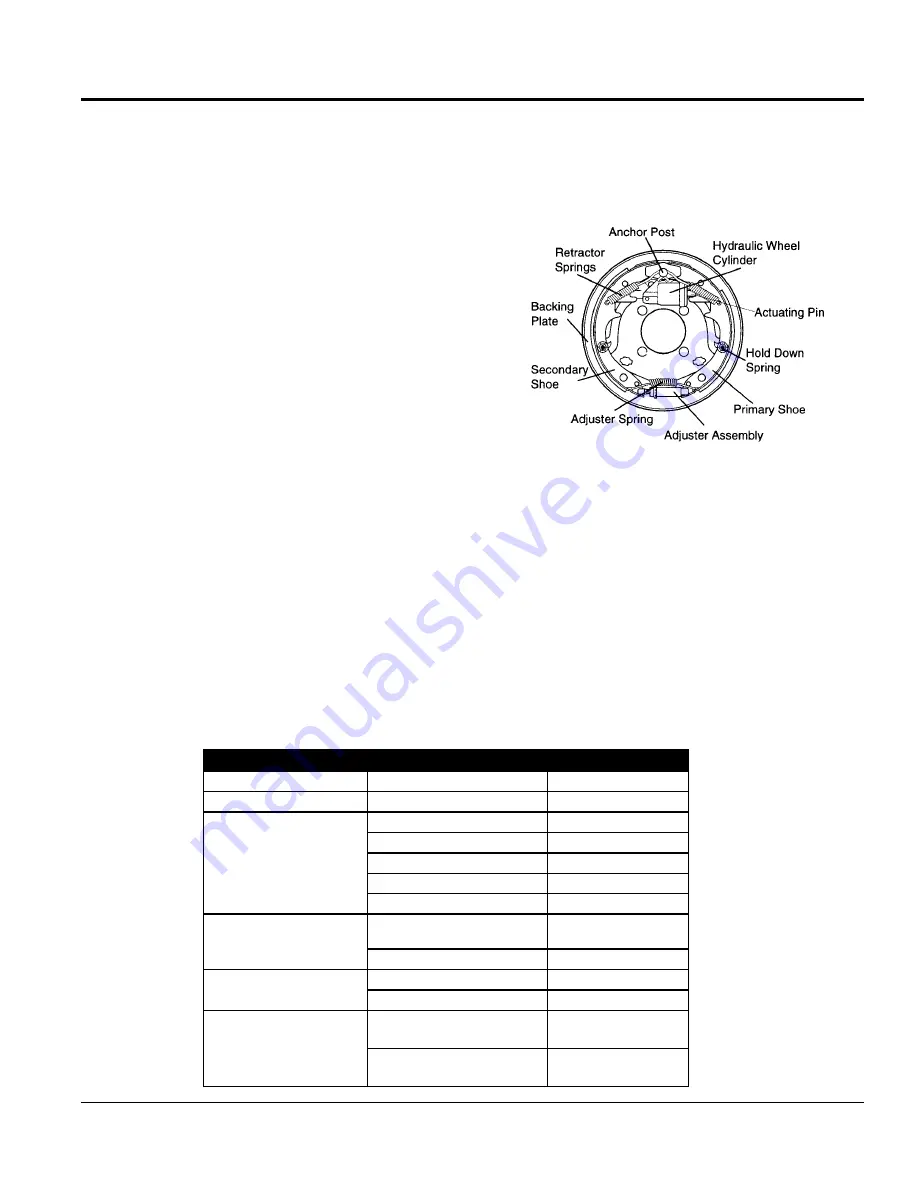
dca220sscu/4i 60 hz generaTor• operaTion manual — rev. #0 (10/25/12) — page 43
traiLer MaiNteNaNCe
BraKes
Trailer brakes should be inspected the
first 200 miles
of
operation. This will allow the brake shoes and drums to seat
properly. After the first 200 mile interval, inspect the brakes
every 3,000 miles.
If driving over rough terrain, inspect the
brakes more frequently.
Figure 62 displays the major hydraulic surge brake
components that will require inspection and maintenance.
Please inspect these components as required using steps
1 through 8 and Table 13 as listed below:
Brake adjustment
1. Place the trailer on jack stands. Make sure the jack
stands are placed on secure level ground.
2. Check the wheel and drum for free rotation.
3. Remove the adjusting hole cover from the adjusting
slot at the bottom brake backing plate.
4. With a screwdriver or standard adjusting tool, rotate
the star wheel of the adjuster assembly to expand the
brake shoes.
5. Adjust the brake shoes outward until the pressure of
the lining against the wheel drum makes the wheel
difficult to turn.
6. Adjust, rotate the star wheel in the opposite direction
until the wheel rotates freely with slight lining drag.
7. Replace the adjusting hole cover and lower the trailer
to the ground.
8. Repeat steps 1 through 7 on the remaining brakes.
hydraulic surge Brakes
Hydraulic surge brakes (Figure 62) should not require any
special attention with the exception of routine maintenance
such as shoe and lining replacement. Brake lines should
be periodically checked for cracks, kinks, or blockage.
Figure 62. Hydraulic Brake Components
actuator
Hydraulic surge braking requires the installation of an
actuator at the tongue of the trailer. Remember the
surge
or push
of the trailer toward the tow vehicle automatically
synchronizes the trailer brakes with the tow vehicle brakes.
As the trailer pushes against the tow vehicle the actuator
telescopes together and applies force to the master
cylinder, supplying hydraulic pressure to the trailer brakes.
Periodically check and test the surge “actuator” to make sure
that it is functioning correctly. Never use an undersize actuator.
Table 13. hydraulic Brake Troubleshooting
symptom
possible cause
solution
No Brakes
Brake line broken or kinked?
Repair or replace.
Weak Brakes or Brakes Pull to
One Side
Brake lining glazed?
Reburnish or replace.
Trailer overloaded?
Correct weight.
Brake drums scored or grooved?
Machine or replace.
Tire pressure correct?
Inflate all tires equally.
Tires unmatched on the same axle?
Match tires.
Locking Brakes
Brake components loose, bent or
broken?
Replace components.
Brake drums out-of-round?
Replace.
Noisy Brakes
System lubricated?
Lubricate.
Brake components correct?
Replace and correct.
Dragging Brakes
Brake lining thickness incorrect or
not adjusted correctly?
Install new shoes and
linings.
Enough brake fluid or correct fluid?
Replace rubber parts
fill with dot 4 fluid.
Summary of Contents for MQ Power Whisperwatt DCA220SSCU
Page 5: ...DCA220ssCU 4i 60 hz generator operation manual rev 0 10 25 12 page 5 notes...
Page 51: ...DCA220ssCU 4i 60 hz generator operation manual rev 0 10 25 12 page 51 notes...
Page 54: ...page 54 dca220sscu 4i 60 hz generator operation and Parts manual rev 0 10 25 12 GENERATOR ASSY...
Page 70: ...page 70 dca220sscu 4i 60 hz generator operation and Parts manual rev 0 10 25 12 battery ASSY...
Page 72: ...page 72 dca220sscu 4i 60 hz generator operation and Parts manual rev 0 10 25 12 muffler ASSY...
Page 74: ...page 74 dca220sscu 4i 60 hz generator operation and Parts manual rev 0 10 25 12 fuel tank ASSY...
Page 76: ...page 76 dca220sscu 4i 60 hz generator operation and Parts manual rev 0 10 25 12 ENCLOSURE ASSY...
Page 89: ...DCA220ssCU 4i 60 hz generator operation manual rev 0 10 25 12 page 89 notes...
















































